Chris Baty's Blog, page 253
October 22, 2011
What Makes a Good Female Character?
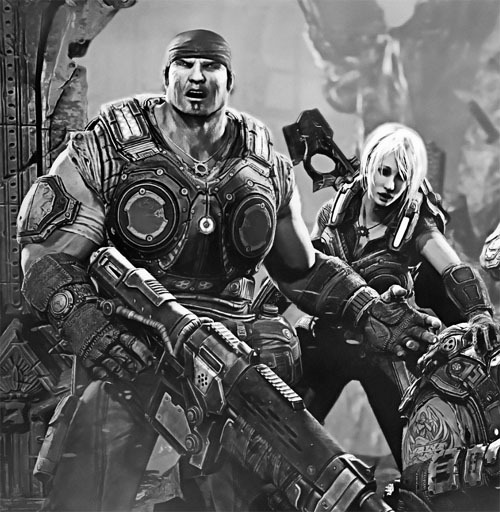
Note: This may be the first OLL game-related blog post. If you are interested in it, you also may be excited to hear that tech writer, game writer, and video host Veronica Belmont has decided to participate in NaNoWriMo this year!
Double note: This blog post includes some minor spoilers.
I recently finished Campaign Mode in Gears of War 3. I play with my brother, who is a Gears of War fan boy in every sense of the word. And for good reason—there are a lot of fabulous things about this game: the Beast Mode option, old maps re-beautified, and really it's still probably the ultimate "bro series," even for lady-bros like me. (But I promised I would write about the writing, and so I shall!) The final installment of the franchise has gotten a lot of praise for its greater presence of female characters, namely Anya, Sam, and Queen Myrrah.
I want to give credit where it's due. For a story about a bunch of dudes without necks in a post-apocalyptic world, Gears of War has an unusual amount of female fans. And when women asked, "Where are the fighting ladies?" many were displeased with the answer the creators gave them: that they were back at home making babies. The explanation felt flimsy at best, and lots of female fans didn't like the idea that women in the story were relegated to an off-screen collective of human incubators. So, this time, having two very present and playable females is a lovely change. Bonus points in that there's no bikini armor to speak of!
While playing, however, I kept having the distinct feeling that the Gears writers were having a little trouble writing women. Their participation was sort of uninspired. Anya Stroud serves as the benign love interest of the main character, but you really can't tell until the very end because there's absolutely no chemistry between them. During the final scene when she grabs Marcus Fenix's hand, my brother said, "Wait—they're together?" But it didn't make a difference to me. Marcus may as well have been dating a brick. I felt like the writers tried to make her agreeable, and so she ended up having no personality whatsoever. Queen Myrrah struck me as such a Disney villain that she was hard to take seriously. And she fits the Disney bill in that she's a woman, but not a woman. She's also a monster. Seriously, think of all the Disney villains like Ursula or Maleficent who are ladies, but not ladies (and not just because they have terrible table manners and whatnot). She's a leader of an army of alien bugs, she wants to kill you, and the question about whether or not she is human is never addressed.
But I think Sam gets the brunt of the bad writing. Sam is not only female, she also serves as a constant reminder of her femaleness. It's not always her fault. The writing dictates that another character, Baird, has to say something fleetingly misogynistic every so often, whatever the circumstance. In one scene, the team has to split up. And when choosing whether or not to go across the catwalk, Baird provides you with two comments. If you do choose the catwalk: "That's the only catwalk Sam's ever gonna walk on!" And if you don't: "Yeah, Sam definitely doesn't have that catwalk look!" It's a lose-lose. In another scene, Baird asks her if she's going to nag the enemy to death, which made me raise my eyebrows, as none of the characters had done any nagging, least of all Sam. There were plenty more needling comments from this character that made me furrow my brow and say, "Really?" And in any case, when it comes down to it, Sam is a tried and true female archetype. Give a smokin' lady a Boltok pistol and make her say tough-girl things, and you don't really have to work on writing the rest of her.
I feel like the writers couldn't quite figure out what to do with these women. They tried making them baby-mamas and that didn't work out. So they found other roles that we've seen a million times. They did right by their female fans in giving them more visibility, but of course visibility is only one step in the right direction. With a game that looks as nice as it does, and plays as nice as it does, could it hurt to ask for some quality writing?
Writers, I want to know: What kinds of attributes would you consider necessary for a good female character? Who's your favorite, fully-formed female character in any genre or medium?
– Ari
October 21, 2011
"I Sold My NaNoWriMo Novel!" A Q&A with Anna Sheehan
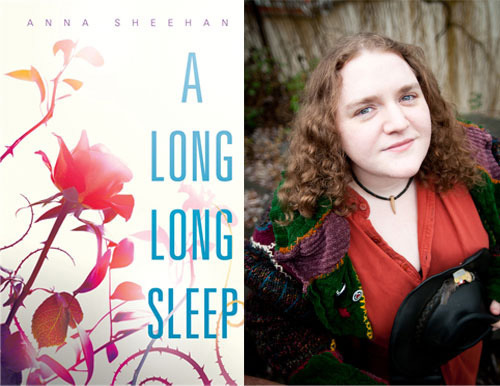
Writer Anna Sheehan sold her 2008 NaNoWriMo novel, A Long Long Sleep, to Candlewick Press in the US. Since then, the young-adult novel has been snapped up by publishers in Russia, Brazil, France, Germany, and the UK (where it was bought in a three-book deal). The book came out in the States this August. We spoke with Anna through the interwebs to get the scoop on her internationally adored book.
What's the connection between NaNoWriMo and A Long Long Sleep?
A Long Long Sleep was written in the autumn of 2008—my third NaNoWriMo book. The month of October was spent researching economic patterns and psychology. November, I disappeared into a novel. December, I did a little polish work, and then sent it off to an agent who had expressed interest in my career. And she took it on!
This was actually one of the easiest books I've written, and it was mostly thanks to NaNoWriMo. I was so grateful that I made sure to put the word "nano" somewhere in the text. Not all books come so easy. Sometimes at the end of NaNoWriMo I have 60,000 words of disconnected, incoherent prose that will never, under any circumstances, see a bookshelf. But sometimes, the process helps me to strike absolute gold. Like it did in 2008.
What lessons did you learn from revising A Long Long Sleep that surprised you?
Well, my original revision was standard. After that, I had to learn to kill babies and make things more clear. But the biggest lesson I learned from the publishing process was simply how interminably long the process is. It was a year before my agent decided the thing was ready to try to sell, it was several more months before it sold; all in all, the length of time between the writing and putting the book on the shelf was more than three years. In short, I learned, go write another book. The only way to fight against that kind of interminable time is with sheer numbers.
You've been writing for most of your life. How does it feel to have your first novel out on bookstore shelves?
Well, good and bad. Being a debut author is not like becoming a movie star. It's more like standing on a street corner saying, "Look at me! Please!" while at the same time trying not to be annoying. Fine line to walk, there. You don't become a bestseller overnight. I'm becoming increasingly aware that, hour for hour, I might as well be digging ditches. But I enjoy it so much that it doesn't feel like working, so I couldn't stop, even if I never made a dime out of it. Hopefully output and input will even itself out over time. But at the same time, my book has already sold in Germany, France, Brazil, Russia, and the UK, as well as America, so the idea that my words, and my story, are out in the world, touching people, is something I just can't fathom. It's what I've always wanted. In short… it's wonderful.
Are you taking part in NaNoWriMo this year?
Always. I'd feel remiss if I didn't. I need my monthly pilgrimage to another world, worshiping at the alter of the computer screen, to keep myself sane. I try to write two novels a year (barring unforeseen disaster). If I'm going to write a novel, NaNoWriMo is the most painless way to force it out of my skull. I hope everyone who participates in NaNoWriMo enjoys it as much as I do. That's the important thing, after all.
Find out more about Anna on her website and Facebook page!
October 20, 2011
Why Do You Write?
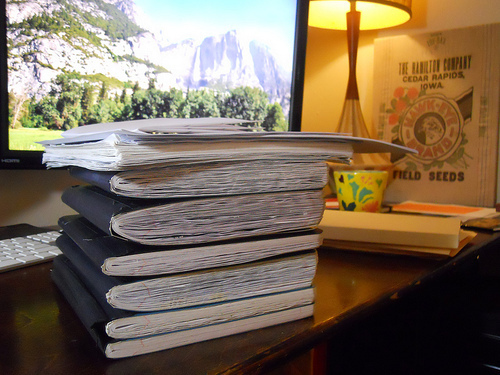
As part of the National Day on Writing, and the National Writing Project's "Why I Write" campaign, we asked NaNoWriMo staff and interns to think about their own reasons for writing.
Why do you write? Take part in the conversation:
Answer in the comments.
Answer on our Facebook page.
Answer on Twitter with the hashtag #whyiwrite. (Tweet @NaNoWriMo, and we'll retweet our favorite ideas!)
Tim, Office Captain: I write because it helps me learn. Creating characters, and stories, and incidents—it's an exercise in wondering, "Maybe the world works like this. Or like this."
Sarah, Community Liaison: I write because I love words, and finding that perfect turn of phrase makes me feel like a genius, if only for a moment. I write because sometimes, the story tumbles out of my fingers faster than my brain can keep up with, and I surprise myself even as I put the words down on the page. I write because for all the suffering it takes to get to that point, there is no feeling in the world like when your story finally clicks.
Lindsey, Program Director: I write because so many things are better read than said. Misunderstandings are too easy in spoken communication; we talk so much and so fast and with so many interruptions! Writing is a haven where I may sit with a concept, clarifying here and editing there, until I can stand back and say, "Here. This is exactly what I mean."
Chris B., Executive Director: I write because I love making people laugh, and the written word is an unbeatable joke-delivery device. I write because conjuring sentences and stories still seems like magic to me, and I don't get many other opportunities to feel like a magician. Mostly I write because I want to find out what happens next.
Max, Intern: I write because once something is written down, I can move on. Writing and printing a story is giving a memory a place in the world.
Emily, ML Captain of Capital Ideas: I write because my mother read to me when I was little, and because of the magic worlds I inhabited when I could read for myself. At our house people read everywhere—you stepped over them to get up the stairs. Words are seeds that grow into stories—neat garden rows and wild jungles of the imagination. By writing, I discover things I didn't know I knew—not just forgotten facts, but truths about the human condition. I write for love, enjoyment, escape—and the sheer joy of it.
Paige, Intern: You know that second when you're reading a book, and something clicks? It can be something you realize about the world, or about how people work, or about yourself, or even about the peculiarities of being a giraffe… I write for that split second. I write because there are so many important emotions and ideas, and they need to be shared. I write to connect. I write in the hope that my words will have an impact—some sort of meaningful repercussion within a reader's soul or mind.
Heather, Forums Moderator: I write because I don't have a choice. I've always got these stories in my head, and they tend to drive me crazy if I don't get them out! Dreams become nightmares, other things start growing wings and flying away… but writing them down excises them. Now, I have more motivation for writing: my children. I have two little girls who love stories, and are always asking me for more. This way, I don't have to buy new books… I can just tell them a new story!
Chris A., YWP Director: I wish I could just borrow Joan Didion's wonderful answer, but that would contradict my own reason: I write to say something that hasn't been said before—or at least, not quite the way I would put it. On better days, I write to interest and amuse myself; on the best days, because I think I can interest and amuse others. Also, to appease the hellhounds.
Ari, Intern: Writing is a huge exercise in delayed gratification. My gut reaction is to say that I write because it's fun, but in the moment of writing, nothing could be less fun. I'm stressed out, anxious, and I can't make up my mind about anything. But in the end—after the adverbs are pared away, characters are revised, and I've labored over the story from first sentence to last—I've created something that I love. And being able to declare "I made this" is the most satisfying feeling of all.
Photo by Flickr user anotherpioneer
October 19, 2011
What's Your Noveling Achilles Heel?

Ask just about any writer, and they will be able to name their literary strong suit and their literary weak spot. Actually, they'll probably all be able to name the weak spot, and only the somewhat confident ones will have the strong suit. (Writers are kind of a self-deprecating bunch.)
Up until very recently, I was quite sure of both my greatest strength and my weakest link. For all my writing flaws, and there are many, I think my dialogue is pretty great. There are times when it's a little too witty and self-aware, sure (and here's that self-deprecating side!), but overall I write it quickly and I think it's pretty snappy.
And if you'd asked me about the weak link up until about a week ago, I would have said it was settings. I'm not big on description, so my novels lack a strong sense of place. It's something I've been actively trying to work on, and it's coming along, if a little slowly. But when I was working on my novel outline last week, I came to a sudden realisation that my real Achilles heel is pacing.
I completely lack the ability to pace a novel.
Part of this is inherent in the first draft process, of course. A novel doesn't really hit its pacing stride until several drafts in, and I pretty much never get to that point. But I think if I had some semblance of a respectable pace in that first draft, I'd have an easier time starting the editing process.
I was lamenting my lack of skills in this arena over on Google Plus the other day (where there is a bustling NaNoWriMo community, incidentally), and a friend of mine sent me this video, which is both educational and entertaining. So with this in mind, I'm going to try to create some sort of consistent pace in my novel this year. I'm working on plotting the major points out in short form (possibly involving a graph!), and I'm planning to be mindful of it while I'm writing.
What's your downfall as a writer? What are you doing to try to combat it this year? And in an attempt to not be self-deprecating writers for a minute, what's your greatest strength as a writer?
– Sarah
Photo by Flickr user texmex5
October 18, 2011
Title Before Plot?! I Must Be Nuts.

My first two NaNos, I had no inkling what I was writing about until the eleventh hour when I sat down in my Halloween costume, AlphaSmart in hand, and started writing.
This year, with November a mere 13 days away, I have a title and loosely formed plot for my NaNo-novel. This was the case last year, as well. But unlike 2010's pre-November plan, my title came first this time around.
Nobody Likes Brazil Nuts.
I made that declaration about a month ago while eating a can of Planter's Deluxe Mixed Nuts, and decided I really liked the ring of it—and the truth in it—though I had no idea what a story with that title might be about.
Somehow, having a title—any title—felt really reassuring; almost like a promise that if I sat with it for a little while, the rest would emerge.
And the plot did come, eventually: An irrepressibly joyful meter maid named Lolly is forced to reconsider her simplistic views on life when a routine ticketing goes awry.
To those Planners out there, what came first for you this year: the plot or the title? Post your novel title here to be eligible for the 2011 NaNoWriMo journal giveaway next Tuesday, October 25! (It's the perfect place to continue your 2011 NaNo-novel planning!)
While you're at it, submit your brilliant plot summary to the 30 Covers, 30 Days nominations thread for the chance to have a book cover designed around your story!
– Lindsey
Photo by Flickr user Satoro Kikuchi
October 17, 2011
Cue the Fanfare: 30 Covers, 30 Days Time!

Big news, one and all! Big, huge, epic, and life-changing news!
This is my first blog post. Gosh. Just… wow. It's a thrill to be here.
Oh, also, there's this little thing called 30 Covers, 30 Days that's on its way back for NaNoWrimo 2011. But that's really the sidebar to the feature story that is: Tim Kim's First Blog Post. If you listen, you can already hear the odes being composed about this day.
Look, you already know all about this 30 Covers, 30 Days thing. You know that the cool kids call it 30C30D. You know that John Gall, VP and Art Director for Vintage/Anchor Books, has been heading up a crack team of designers who whip up a book cover a day during the month of November—pulling off feats of design that are Cirque du Soleil-worthy. You know that the event's all of three years old, but has already spawned some incredible art for your incredible stories (precocious enough to be the scene-stealer on an ABC sitcom, yo).
What don't you know? What an Office Captain blog post is going to look like with Tupelo gone. (Spoiler alert: less well-written for one.)
(Double spoiler alert: experiments with fairly cheesy catchphrases, like "spoiler alert," for another.)
This 30 Covers, 30 Days thing is pretty nuts. Mr. Gall's got some experience with being a maestro, the capo to a crew of heavy-hitters. In 2009, he oversaw a team that redesigned all of Vladimir Nabokov's book covers; their final product is ridiculously beautiful. This is the guy who's going to supervise as 30 Wrimos' synopses are turned into book covers like this one. Or this one.
Now, there's been a lot of speculation about how we choose the novels that receive a cover. Wombats? Time-traveling ghosts? Predestination? Sure, those were my first thoughts, too. But I suspect the answer's in the technology: our ever-brilliant duo of Dan and Jezra have reprogrammed a couple of Roombas we have on hand, and they're now clicking away constantly at their MacBook Airs as they trawl through synopses and titles to pick out the lucky 30.
The Roombas are real cute. We call them Botman and Robin the Bot Wonder. (Though we're open to renaming them. Suggestions?) They'll be keeping an eye out from mid-October through November. Get those synopses ready!
In the meantime, check out the 30 Covers, 30 Days forum. Throw in a worthy novel in our nomination thread! Talk up your favorite covers from last year, or your favorite book cover ever!
I'll be working on my second blog post. It's pretty clear that's where the stunning personal revelations are going to lie. The pearls of wisdom that will change the very chemistry of brains. Get ready!
Keep on keeping on (What do you think of this sign-off? No? "Keep on trucking"? Hmm…),
– Tim
Photo by Flickr user Klara Kim
October 14, 2011
It's Recruiting Season!
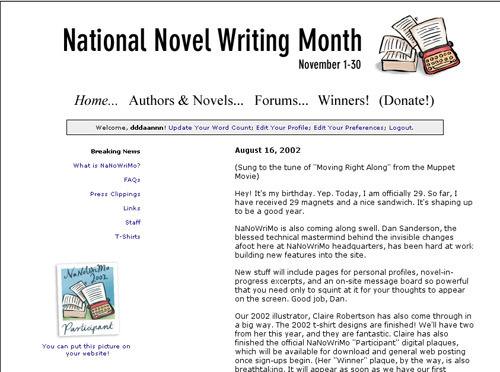
Way back in the day when I joined NaNoWriMo, things were a little different. The year was 2002. There was no Facebook, no Twitter—heck, there wasn't even a MySpace. Many of us were still connecting to the internet using dial-up, and laptops were a little harder to come by. (I was not wearing an onion on my belt. This blog post is making me feel about a million years old. 30 is the new 20, right? I'm still young and hip, I swear!)
We still had the website, of course, but things weren't quite as slick then as they are now. And with only about 13,000 participants, the regional forums weren't as hopping as they are today. So when I decided to sign up for NaNoWriMo, I figured the best way to ensure I wasn't doing it on my own was to attempt to recruit pretty much everybody I knew.
My friends got the hard sell. They were used to it by then; whenever I become a fan of something I pretty much flail around at my friends until they decide that trying it is easier than putting up with me. (Previous incidents include but are not limited to: Mac computers, TiVo, various television shows, Twitter, and Disneyland. My track record is excellent on all those items.)
A healthy brigade of my friends signed up that first year, and although none of them have participated every year, they've all written novels on and off. As time went on, I recruited more of my friends, including Karen, who eventually became my co-ML. (That was my secret plan all along, as I knew Karen would be a much better ML than me. She's pretty much the most organized person on the planet.) We enticed Karen's husband Paul a few years back as well, and now he, in turn, is recruiting others.
Partially as a result of Paul's efforts, this year is the first year in a while that several more of my friends have decided to take the plunge. Maybe they got tired of never seeing me or Karen in November, or maybe we sucked them in with all our posts on Facebook and Twitter about how fun it is. Whatever the reason, this year is the first year in quite some time that we've got new blood in our little group of friends, and I'm excited. We're already buzzing about novel plans on Twitter. We've been notebook and pen shopping (always a key step), and one of my friends is halfway through No Plot, No Problem! already.
There are a lot of new Wrimos out there, especially as we creep ever closer to that November 1 kick-off. The absolute number-one tip I can offer? Get your friends involved. Take a close look at the people in your life, and decide who would be most easily convinced to take this wild ride with you. There's nothing like a real-life noveling buddy to keep that motivation high, and once you start recruiting other people, you're really on the hook yourself!
Have you recruited your friends to the NaNoWriMo madness? How did you do it?
Screenshot from the 2002 NaNoWriMo website, featuring the tippy typewriter (I loved that thing) and Chris Baty commenting on his 29th birthday. Those were the days!
– Sarah
October 13, 2011
NaNoWriMo YWP's (Early!) Launch
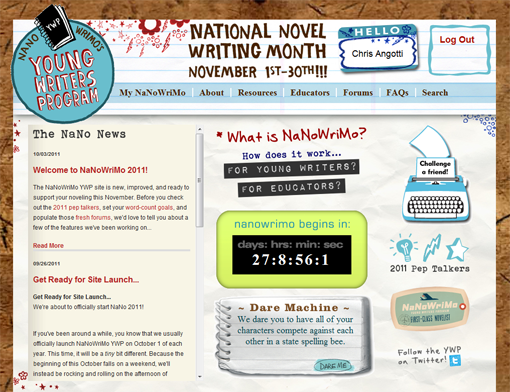
When NaNoWriMo.org triumphantly launched on Monday, the precocious Young Writers Program had already been up and running for a week. After all, there's only so long you can wait when excited young authors are ready to get going. The YWP didn't get fancy new innards this year (soon, we hope), but we are still pretty hyped about the 2011 site we put together.
The first obvious change is our homepage, which you can see above. Pretty, right? We wanted a simpler design, with clear entry points for both everyday users and new visitors. That's been accomplished through the expanded "NaNo News" (which will be the spot for important updates, pep talks, and videos all season long) and the handy "What is NaNoWriMo?" block.
Next, young writers' profiles have been graced with a full set of statistics for the first time. In November, that space will be packed with helpful NaNo numbers to spur our kids and teens toward their noveling goals. Also, this one's for the math teachers out there: a sweet word-count line graph! Let the slope calculation begin!
To be totally sure our participants are trying to reach the top of that chart (and not just crunching numbers), we've made all of our resources way more accessible. Want the stuff for young writers? Boom. Want the stuff for educators? Double boom.
And improved forums? Darn straight. Our Wrimos are getting even chattier thanks to our new moderator Cylithria.
The Virtual Classrooms we introduced last year have gotten some attention, too. Now, multiple educators can work together in one classroom, and soon they'll be able to "challenge" others in head-to-head word-count match-ups. (I over-hyphenate when-I'm-enthusiastic.)
We've even got a few more things up our sleeve, plus the usual awesome pep talks by your favorite YA authors. From launch to December 1 (and beyond), the Young Writers Program is going to be rocking it this year. Hope you'll come by and check us out some time.
– Chris A.
October 12, 2011
Tool for the Tentative Writer
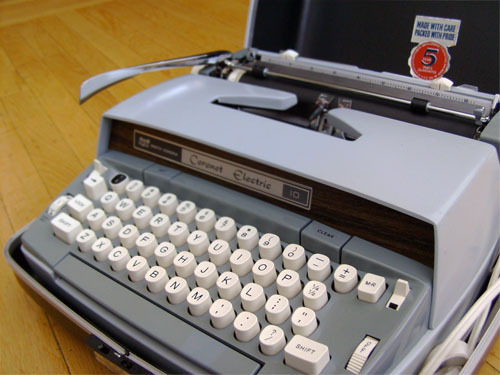
This is my 1976 Smith-Corona typewriter. My dad gave it to me recently after he helped clean out a friend's house, and my plan was to use it when November rolled around. I have mixed feelings about owning a typewriter, but the dominant feelings are ultimately love and guilt. I feel guilty, of course, because it's liking something for the nostalgia of it. Something from the mid-70s is so novel and fresh nowadays, and I can see my poetry professor rolling his eyes at me, thinking about the days when students used typewriters because they didn't have anything more awesome, like the internet. Mostly I feel guilty because now I can legitimately be called a hipster. My dreams whisper the accusation to me while I sleep at night. One thing to know—this kind of guilt is best quelled by rolling over and sleeping some more.
I love it because of the way it sounds. It's loud. As I type, I can feel the force of each letter being smacked down onto the page, like, "Ha! I just wrote a 'G'! What do you have to say about that?" A desktop keyboard's noncommittal clickety-clicks are no match for my Smith-Corona, where each stroke sounds decisive. And even when I make a mistake (which, believe me, there are many), I somehow put faith in the typewriter's ability to see me through to the end. It emits a low rumble when it's plugged in, drowning out any distractions, and there's a sorry excuse for a backspace button that only lets me type over a mistyped letter, or punch hash marks over an ill-chosen word (the backspace key also points the exact opposite direction that a backspace key should point). The thought of not being able to edit the way I normally would is frustrating. But because of this tough lovin', I can manage to fill up a page pretty quickly.
Unfortunately, I cannot attest to the idea that a typewriter will make you a better writer. It may, in fact, make you a worse writer. I wrote three letters on my typewriter, all of which remained unsent. Not being able to edit means having to live with what you've written (or not—what were formerly my letters are now all in the recycling bin). This can be awful, or it can be totally great, but one thing I know for sure is that it's perfect for NaNoWriMo. In her pep talk, Lynda Barry advises writing by hand for these same reasons.
I recommend using a typewriter if you suffer from the following:
habitual editing
indecisiveness
second-guessing every sentence
distractions via the internet
repeated word-count checking
Do you have any ultimate writing tips to share? At midnight on November 1, I'll be in my Ash Ketchum costume, sitting at my typewriter, considering every bit of advice. Believe me, some of us will be needing it!
– Ari
October 11, 2011
A Technical Education
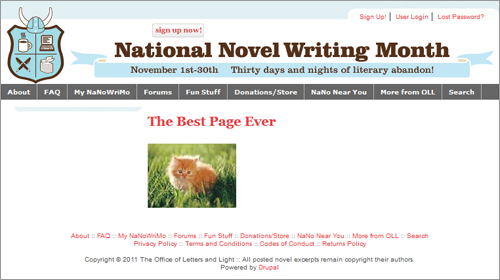
Three years, 2 months and 24 days ago, I came on board at OLL as the first employee to hold the title of Community Liaison. I had a writing and business background, but I was pretty weak on the technological know-how.
Lucky for me, overseeing volunteers didn't expressly require that I have great programming chops or anything. But it did require that, in my very first week, I learn some rudimentary HTML.
The first thing I created on the site was called The Best Page Ever, and featured photographs of a bearded man and a kitten, as well as a list of my favorite foods in descending order. (I aced the HTML portion of the test, but accidentally published the page, to the confusion of a few very vigilant Wrimos.)
Fast forward three years. The Best Page Ever is still stored in our database (though it's now unpublished, thankfully). And we are pulling the curtains back on the second website I've ever helped create: the brand new Rails-built NaNoWriMo.org (the first being the Camp NaNoWriMo website, released this summer).
From uploading that first photo of a tiny orange kitten in a meadow, to writing the final text for the last page on the 2011 NaNoWriMo site, I have had to shed my cloak of blissful ignorance and step well beyond my comfort zone into the land of development and web design. As Program Director, I could no longer cower behind my shield of good customer service and jovial phone-answering.
No, indeed; it become urgently necessary that I take some serious tech protein powder and build a little knowledge muscle.
So I learned what the heck a widget is (can I be honest? I still get confused); I got really intimately familiar with our bug reporting system, Trac; and I had to bare my absolutely appalling lack of knowledge about Illustrator, layers, and countless other elements of design when planning the new looks of Camp and NaNoWriMo.org.
The learning curve has been extra-steep, my friends. But it has also been so outrageously rewarding.
Working with the heroic development team we've been gifted with, led by the absolutely brilliant and dedicated Dan Duvall, has been amazing. For the past six months we've been in near-constant contact with the superhuman crew of Beezwax developers working from Argentina; Jez has cut his teeth to excellent effect on Rails code for the first time; a tremendous horde of Beta Testers enthusiastically vetted every last inch of the new NaNo site; and those testers were led by the most incredible group of staff and volunteers known to nonprofit history.
From my position in this overwhelming new world of technology, I'd just like to take a moment to thank with my whole grateful heart: Dan, Jez, Pedro, Francisco, Marquete, Heather, Rob, Emily, Cylithria, Cybele, Kathy, Sarah, Ari, Paige, Max, Tim, Chrises A. and B., Tavia, Tupelo, Nancy, Maury, Graham, and Heather G-M.
And I want to thank you for having faith in this project and being patient while we produced it.
On the behalf of everyone here at NaNoWriMo, I humbly submit the 2011 website to you, with full knowledge that it isn't perfect… yet. And equal assurance that it was built with utmost love and care.
– Lindsey
Chris Baty's Blog
- Chris Baty's profile
- 63 followers



